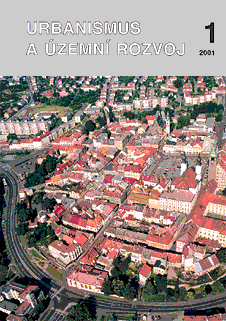
Another Look at the AESOP Congress
The 14th congress of the Association of European Schools of Planning (AESOP), held on 18 to 23 July 2000 in Brno, has partly been reviewed in the previous issues of UPSD. One of the details we still have not mentioned – and which we are proud to announce now – is that one of our editors, Karel Maier, was elected vice president of this organization. Congratulations from the editorial staff!
Taking another look at the congress, we want to focus on the information and knowledge the congress has presented, which is not easy. The congress was attended by participants from all over the world, not excluding Australia, New Zealand, or Africa. The proceedings of the congress consist of shortened versions of more than 160 papers, divided into 13 sections. The topics are largely varied, from global problems and futuristic visions to specific case studies from various corners of the world. Equally varied is the circle of contributors, from venerable professors of renowned universities to students from underdeveloped countries. This is what we consider unique about the AESOP congresses. They offer space for everyone, creating thus a comprehensive view of the actual state and of the instructional methods in physical planning throughout the globe.
This issue brings the important opening papers, related to the present and future situation of physical planning in the Czech Republic.
Also, we aimed at choosing articles which may contribute to the debate on the evolution of physical planning in this country and bring more ideas to the draft of the new physical planning law.
To suggest a basic idea, the following articles are published in this issue of UPSD:
Czech Physical Planning at its Turning Point by Martin Tunka
Planning in a Post-planned Society: Who Needs Urban Planners? by Karel Maier
Physical Planning at Crossroads by Cliff Hague
The Policy and Concept of Physical Planning on European Scale – The Impact on the National
Physical Planning Systems by Karina M. Pallagst
Border Areas as Places for Mediation — Opportunities for Inter−municipal Cooperation in the Bohemian−Saxon Border Area, by Milan Jeřábek, Kateřina Kučera, Bernhard Müller and Jan Přikryl
The problems of spatial development are not restricted by state borders. Actions and decisions taken on one side of the frontier have their impact on the neighbouring territory. So, the expression place for mediation is related to the particular identity of the border area. The creation of a crossborder community, through personal and institutional contacts, is a necessary base for the evolution of joint prospects and interests and for the outward presentation of the newly formed crossborder region. In view of the European integration, questions of international cooperation between bordering municipalities are becoming more and more important. Settlements in such regions are getting closer to each other, thus being pioneers of cooperation across the border of the European Union. At the same time, their key role in the regional development of border areas remains undoubted.